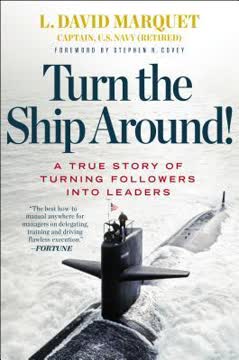Key Takeaways
1. Language shapes leadership: Industrial Age vs. modern approaches
Changing our words changed our world.
Industrial Age leadership relied on coercion, compliance, and conformity. This approach separated thinkers from doers, creating steep hierarchies and stifling innovation. Modern leadership requires a new language that empowers all team members to think, decide, and act.
Modern leadership language:
- Embraces variability and curiosity
- Invites dissent rather than driving consensus
- Gives information, not just instructions
- Focuses on learning and improvement, not just performance
By changing the language of leadership, organizations can create more adaptive, innovative, and fulfilling work environments.
2. Redwork and bluework: Balancing action and reflection
Doing and thinking are the basic building blocks of all human activity.
Redwork is action-oriented, focused on execution and reducing variability. It benefits from a performance mindset. Bluework is reflective, embracing variability and focused on decision-making and improvement. It thrives on an improvement mindset.
Organizations need to balance redwork and bluework:
- Redwork: Executing tasks, following procedures, meeting deadlines
- Bluework: Planning, strategizing, learning, innovating
The key is to create a rhythm between these two modes, allowing for both efficient execution and continuous improvement. This balance helps organizations stay agile and adaptive in a rapidly changing world.
3. Control the clock: Making space for deliberate decision-making
Never underestimate the power of fear to distort common sense in environments with a strong culture of control and compliance.
Controlling the clock means deliberately creating pauses in work to allow for reflection and decision-making. This play counteracts the Industrial Age tendency to "obey the clock" and rush through tasks without proper consideration.
Ways to control the clock:
- Make pauses possible by not preempting them
- Give pauses a name (e.g., "mariners' minute")
- Call pauses when needed
- Preplan the next pause
By controlling the clock, teams can avoid rushing into poor decisions and create space for thoughtful collaboration and improvement.
4. Collaborate, don't coerce: Fostering genuine teamwork
The wisdom of the crowd can be undermined in several ways. Anchoring and social conformity are two of those ways.
True collaboration involves creating an environment where all team members feel safe to contribute their ideas and perspectives. This contrasts with the Industrial Age approach of coercion, where leaders simply tell others what to do.
Techniques for fostering collaboration:
- Vote first, then discuss to avoid anchoring bias
- Be curious, not compelling
- Invite dissent rather than driving consensus
- Give information, not instructions
By embracing collaboration, teams can tap into their collective intelligence and make better decisions.
5. Commit to action, not just compliance
Commitment comes from within, whereas compliance is forced by an external source.
Commitment involves team members choosing to take action based on their own understanding and agreement. This is more powerful than compliance, which is simply following orders.
To foster commitment:
- Commit to learn, not just do
- Commit actions, not beliefs
- Chunk work into small, achievable pieces
When team members are committed rather than just compliant, they bring more discretionary effort and creativity to their work.
6. Complete and celebrate before continuing
Completion gives us not only a sense of accomplishment, but also psychological separation from our previous activity.
Completion involves deliberately marking the end of a work phase or project. This allows for reflection, learning, and celebration before moving on to the next task.
Benefits of completion:
- Provides a sense of progress and accomplishment
- Allows for learning and improvement
- Prevents burnout from endless work
Celebrate completion by focusing on:
- Behavior, not characteristics
- Journey, not just destination
- Observing and appreciating, not just praising
7. Improve and learn, don't just prove and perform
Improvement—which comes from egoless scrutiny of past actions, and deep reflective thinking about what could be better—is the core purpose of bluework.
The improve mindset focuses on learning and growth, while the prove mindset focuses on demonstrating competence. Organizations need to create environments that encourage improvement over mere performance.
Techniques for fostering improvement:
- Focus forward, not backward
- Look outward, not just inward
- Emphasize process, not just people
- Aim for excellence, not just avoiding errors
By emphasizing improvement, organizations can become more adaptive and innovative over time.
8. Connect with people, don't just conform to roles
Connection is about caring—caring what people think; caring how people feel; caring about their personal goals.
Connection involves building genuine relationships and understanding between team members. This contrasts with the Industrial Age approach of simply conforming to roles and maintaining emotional distance.
Ways to foster connection:
- Flatten the power gradient
- Admit when you don't know something
- Be vulnerable
- Trust first
By connecting authentically, teams can create psychological safety, leading to more open communication and better collaboration.
9. The dangers of goal-setting and steep hierarchies
Specific goals at the strategic level set in motion a cascading mindset of prove-and-perform down the organization—locking people into redwork and raising barriers to bluework.
While specific goals can improve short-term performance, they can also lead to unethical behavior and short-sighted decision-making. Steep hierarchies exacerbate these problems by making it difficult for lower-level employees to speak up about concerns.
Risks of overly specific goals and steep hierarchies:
- Narrow focus that misses important information
- Increased likelihood of unethical behavior
- Suppression of learning and adaptation
Organizations need to balance goal-setting with flexibility and create flatter hierarchies that encourage open communication.
10. Implementing a red-blue operating system for adaptability
In a complex, fast-changing world, long-term survival is more about adaptation than achievement.
A red-blue operating system involves deliberately alternating between periods of action (redwork) and reflection (bluework). This approach can be applied at strategic, operational, and tactical levels to create more adaptive organizations.
Key elements of a red-blue operating system:
- Balance redwork and bluework based on project stage and uncertainty
- Involve all team members in bluework, not just leaders
- Use shorter redwork cycles early in projects, longer cycles later
- Apply the system to individual careers and lifelong learning
By implementing a red-blue operating system, organizations can become more agile, innovative, and resilient in the face of rapid change.
Last updated:
FAQ
What's Leadership is Language about?
- Language's Role in Leadership: The book emphasizes the profound impact language has on leadership and organizational culture, arguing that the words leaders use can either empower or disempower their teams.
- Redwork vs. Bluework: Marquet introduces "redwork" (doing) and "bluework" (thinking), highlighting the need for a balance between action and reflection for effective leadership.
- Transformational Leadership: It advocates for a shift from traditional command-and-control methods to collaborative approaches that foster commitment and engagement.
Why should I read Leadership is Language?
- Practical Insights: The book offers actionable strategies for improving communication and leadership effectiveness in modern organizations.
- Real-World Examples: Marquet uses his experiences, including the Navy and the El Faro incident, to illustrate the impact of language on leadership outcomes.
- Cultural Shift: It encourages moving from a performance mindset to a learning mindset, crucial for adapting to today’s fast-paced work environments.
What are the key takeaways of Leadership is Language?
- Control the Clock: Leaders should focus on controlling the pace of work, allowing for necessary pauses to reflect and make informed decisions.
- Collaborate, Don’t Coerce: Effective leadership involves collaboration and inviting dissent, fostering a culture of trust and open communication.
- Commitment Over Compliance: Commitment should come from within individuals, leading to greater engagement and discretionary effort, as opposed to mere compliance.
What are the best quotes from Leadership is Language and what do they mean?
- “Changing our words changed our world.”: This quote encapsulates the book's thesis that language profoundly influences organizational culture and outcomes.
- “Leadership is about language.”: Marquet emphasizes that effective leadership hinges on communication, which can either inspire or stifle teams.
- “We need a new playbook.”: This statement calls for a shift from outdated leadership practices to more adaptive, collaborative approaches.
What is the difference between redwork and bluework in Leadership is Language?
- Redwork Defined: Redwork refers to task execution, often under time pressure, focusing on efficiency.
- Bluework Defined: Bluework involves thinking, decision-making, and reflection, allowing for creativity and adaptability.
- Importance of Balance: Marquet argues that organizations must balance redwork and bluework to foster innovation and effective problem-solving.
How does Marquet suggest leaders can control the clock in Leadership is Language?
- Make Pauses Possible: Leaders should create an environment where taking a pause is encouraged, allowing team members to reflect and share concerns.
- Give the Pause a Name: Establishing specific phrases or signals for pausing can help team members feel comfortable interrupting redwork for discussions.
- Preplan the Next Pause: Scheduling regular intervals for reflection and evaluation helps maintain a balance between action and thought.
What does Leadership is Language say about collaboration?
- Invite Dissent: Marquet emphasizes the importance of inviting differing opinions to enhance decision-making and innovation.
- Be Curious, Not Compelling: Leaders should approach discussions with curiosity rather than trying to persuade others, fostering open dialogue.
- Vote First, Then Discuss: Allowing team members to express opinions anonymously before discussion reduces bias and encourages diverse input.
What is the significance of commitment in Leadership is Language?
- Intrinsic Motivation: Commitment arises from within individuals, leading to greater engagement compared to mere compliance.
- Actions Over Beliefs: Leaders should focus on securing commitments to actions rather than changing beliefs.
- Learning Mindset: Committing to learning during redwork phases encourages teams to view tasks as experiments, fostering continuous improvement.
How does Marquet address the issue of escalation of commitment in Leadership is Language?
- Recognize the Trap: The book highlights how individuals often stick to decisions due to emotional investment, even when evidence suggests change.
- Separate Decision-Makers from Evaluators: Having different individuals make and evaluate decisions reduces emotional burden and encourages objectivity.
- Frame Decisions as Hypotheses: Treating decisions as hypotheses allows teams to remain flexible and open to change based on new information.
What is the redwork-bluework operating system in Leadership is Language?
- Two Modes of Work: The system consists of redwork (doing) and bluework (thinking), requiring a balance for effective leadership.
- Rhythmic Transition: Leaders should manage transitions between redwork and bluework to ensure reflection and learning.
- Application Across Levels: It can be applied at strategic, operational, and tactical levels, encouraging a culture of learning and adaptability.
How does Leadership is Language define celebration in the workplace?
- Acknowledgment of Efforts: Celebration is recognizing and appreciating team members' efforts and accomplishments.
- Positive Consequences: Celebrating achievements leads to increased motivation and engagement, reinforcing desired behaviors.
- Celebrate With, Not For: Celebrating with team members invites collaboration and shared joy in accomplishments.
What is the significance of psychological safety in Leadership is Language?
- Encourages Open Communication: Psychological safety allows team members to express thoughts without fear, fostering collaboration and innovation.
- Empowers Team Members: Feeling safe encourages risk-taking and idea-sharing, leading to better problem-solving.
- Foundation for Learning: It is essential for creating a learning environment, enabling teams to reflect and improve continuously.
Review Summary
Leadership is Language receives mostly positive reviews, praised for its insightful approach to leadership communication. Readers appreciate Marquet's emphasis on language's role in shaping organizational culture and employee engagement. The book offers practical strategies for shifting from traditional hierarchical models to more collaborative approaches. Some criticize the repetitive nature and similarity to agile concepts. Overall, reviewers find the book thought-provoking and valuable for leaders seeking to improve their communication skills and create empowering work environments.
Similar Books








Download PDF
Download EPUB
.epub digital book format is ideal for reading ebooks on phones, tablets, and e-readers.





